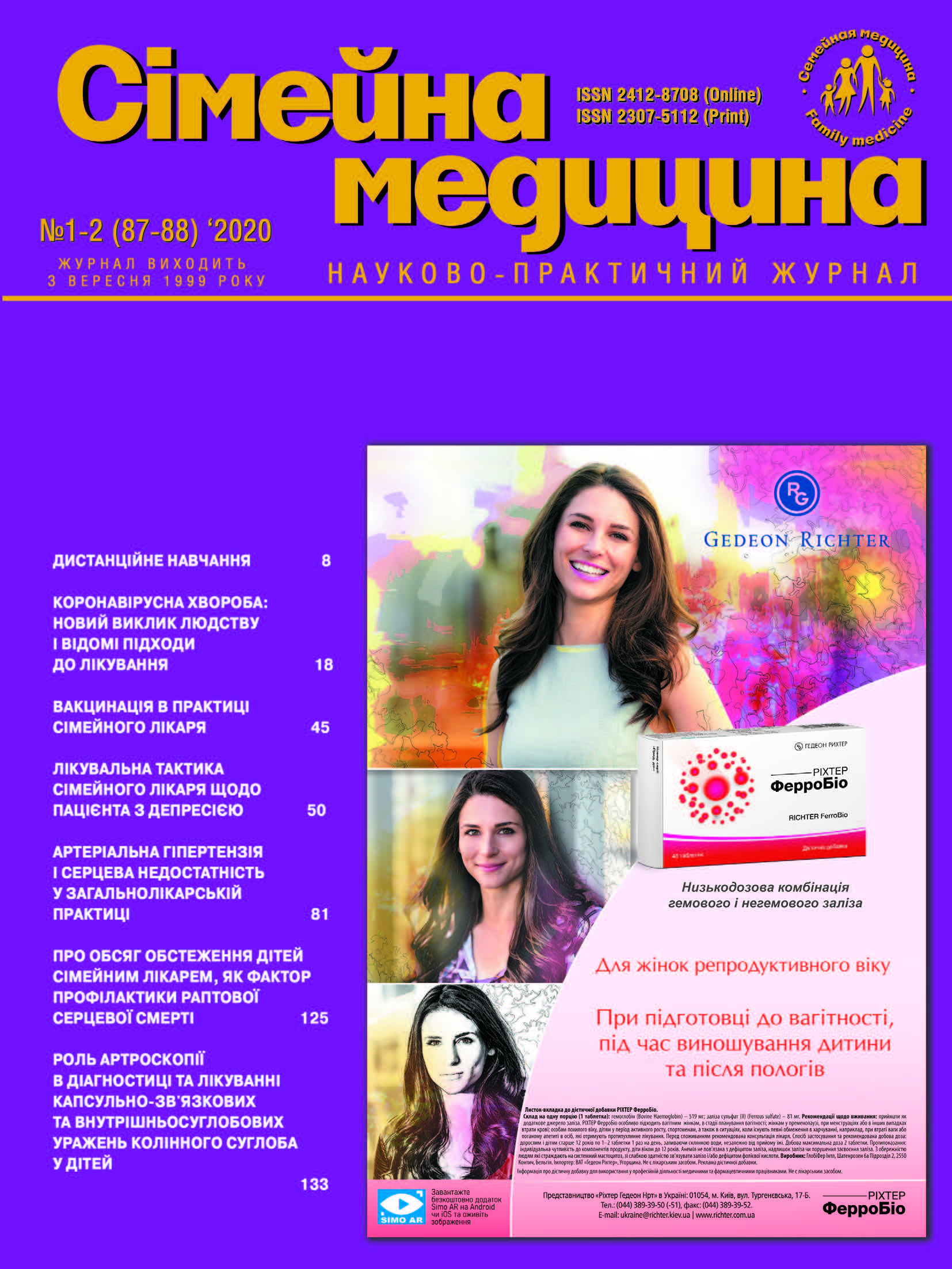Construction of Prognostic Models of Reproductive Health of Men with Chronic Inflammation of the Urogenital Tract
##plugins.themes.bootstrap3.article.main##
Abstract
The objective: to statistically evaluate the effect of chronic inflammation of the urogenital tract, as well as other concomitant factors on reproductive health of men, and also predict the likelihood of being healthy in the future.
Materials and methods. The research is implemented in several successive stages. At the first stage, by means of an expert survey of family doctors, dermatologists and urologists, a system of key indicators for the effects on reproductive health of men was developed, due to the transfer of chronic inflammation of the urogenital tract. At the second stage, the collection of information on key factors of influence through the questioning of men during 2015–2019 by the face-to-face approach during the reception of patients on the clinical bases of the Department of Family Medicine and ambulatory-polyclinic care of NMAPE named after PL Shupik. The survey was attended by 388 patients. In the third stage, on the basis of the established database of interviewed patients, the correlation between the index of reproductive health of men with chronic inflammation of the urogenital tract and the main factors that cause it are established. At the next stage, factor variables have been selected and prognostic models of the probability of decreasing fertility among men who have been diagnosed with chronic inflammation of the urogenital tract have been constructed.
Results. The system of key indicators of the effect on reproductive health of men, as a result of the transfer of chronic inflammation of the urogenital tract is grouped into five blocks: socio demographic characteristics; diseases of the reproductive system in history; adherence to a healthy lifestyle; peculiarities of sexual life; actual sperm parameters. The greatest influence on the negative reproductive health of men who were ill with chronic inflammation of the urogenital tract has demographic characteristics of patients and parameters of sperm. Thus, men over 40 years of age with a pathological morphotype of spermatozoa with a high probability of decreasing fertility in the background or after treating chronic inflammation of the urogenital tract. During the experimental calculations, it has been established that the most appropriate approach in identifying the factors influencing the future of reproductive health of men is the use of linear prognostic models using structural variables. When constructing a prognostic model of reproductive health of men, it is determined that the model is more adequate when combining the factors of each of the five indicator blocks. By the results of the discovery of the most important factor variables for their further use in the prognostic models of the state of reproductive health of men, a method of stepwise regression with «joining» and «exclusion» has been applied.
Conclusion. Two equivalent models are proposed for calculating the probability of decreasing reproductive capacity among men with chronic inflammation of the urogenital tract with an acceptable level of significance of the coefficients of the model and its adequacy in general, at the same time, but the set of factor characteristics in them is different. For the convenience of using the results of simulation and unification of treatment approaches for patients, a scale is proposed for assessing the probability of a decrease in the reproductive health of men from chronic inflammation of the urogenital tract.##plugins.themes.bootstrap3.article.details##

This work is licensed under a Creative Commons Attribution 4.0 International License.
Authors retain the copyright and grant the journal the first publication of original scientific articles under the Creative Commons Attribution 4.0 International License, which allows others to distribute work with acknowledgment of authorship and first publication in this journal.
References
The Law of Ukraine «The Fundamentals of Ukrainian Legislation on Health Care», Article 35¹.
Order of the Ministry of Health of Ukraine dated March 19, 2015, No. 504 «On Approval of the Procedure for Provision of Primary Health Care».
Verbets VV. 2006. Methodology and method of sociological research: Educational and methodical manual. – The second ed. Rivne: RDU: Institute for Social Studies. 168 p.
Gorpinichenko II, Poroshyna TV et al. 2009. Chronic abacterial prostatitis: Immunological study of ejaculate. Health of the man. 2: 80-82.
Demchenko AN. 2004. Dysfunctional hypofertility in men, the latest approaches to its classification, diagnosis and therapy. News of medicine and pharmacy. 13:16-18.
Lyahg Y, Guriyanov VG. 2004. Fundamentals of Computer Biostatistics: Analysis of Information in Biology, Medicine and Pharmacy by the Statistical Package of MedStat. 212.
Tiktinski SL. 1990. Andrology Guide.
Tkach EI., Storozhuk VP. 2009. General theory of statistics: textbook [for the student. Higher teach eng. K.: Center for Educational Literature. 442 p.
Azenabor A, Oloruntoba Ekun A, Akinloye O. 2015. Impact of Inflammation on Male Reproductive Tract. J Reprod Infertil. 16(3): 123–129.
Baker P, Shand T. 2017. Men’s health: time for a new approach to policy and practice? J Glob Health. 7:010306.
Glazer CH, Bonde JP, Eisenberg ML, Giwercman A, Hærvig KK, Rimborg S, Vassard D et al. 2017. Male infertility and risk of nonmalignant chronic diseases: a systematic review of the epidemiological evidence. Semin Reprod Med. 35:282–290.
Hollanders J.M.G., Carver-Wand J.A. 1996. Male Infertility – from A to Z. 94.
Levine H, Jørgensen N, Martino-Andrade A, Mendiola J, Weksler-Derri D, Mindlis I, Pinotti R, Swan SH. 2017. Temporal trends in sperm count: a systematic review and meta-regression analysis. Hum Reprod Update. 23:646–649.





